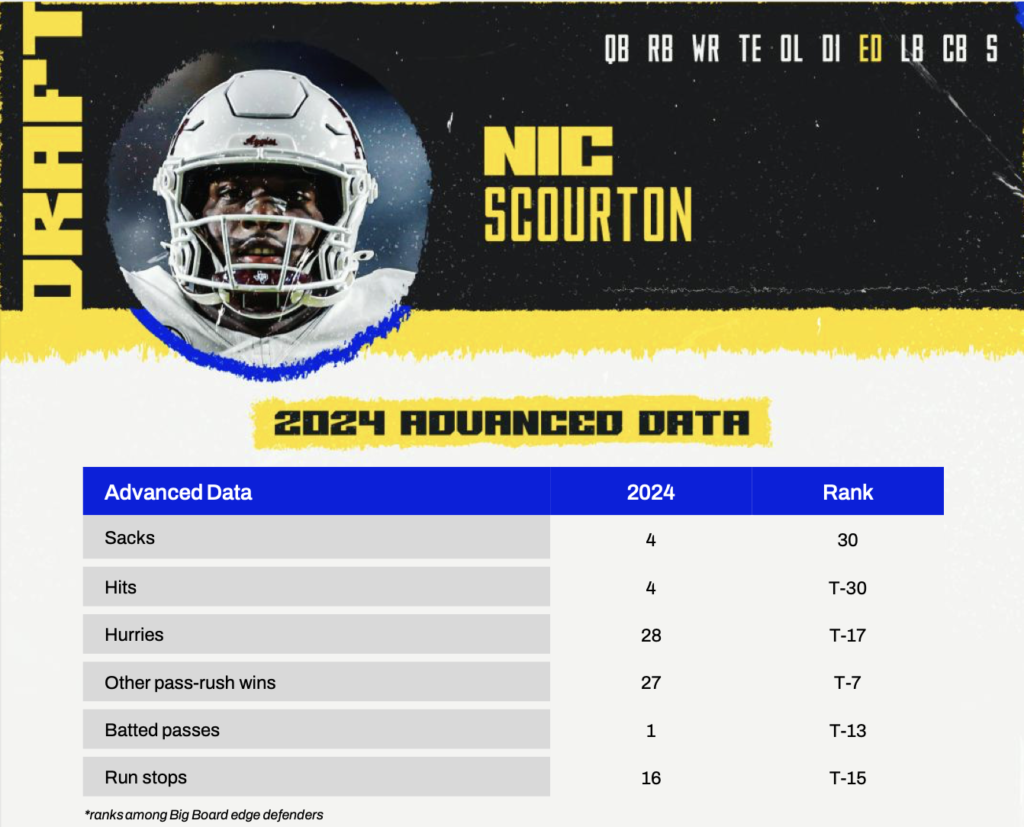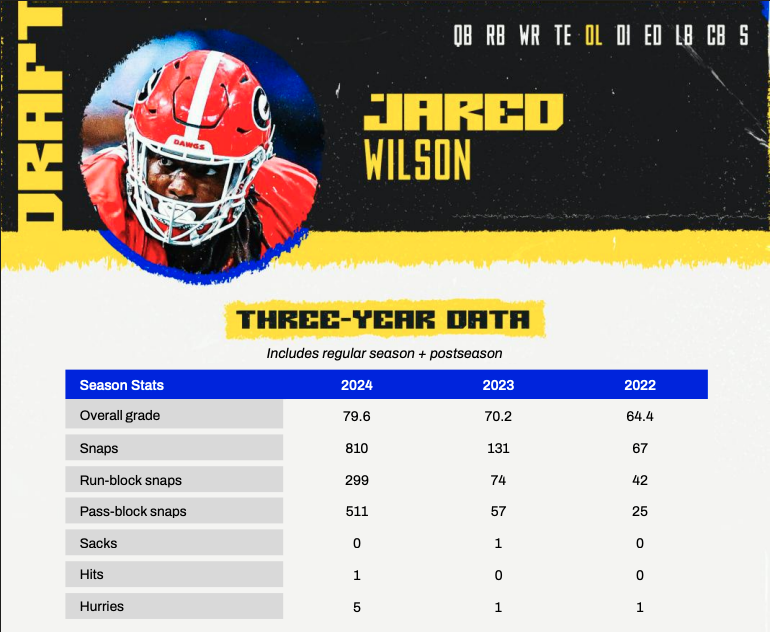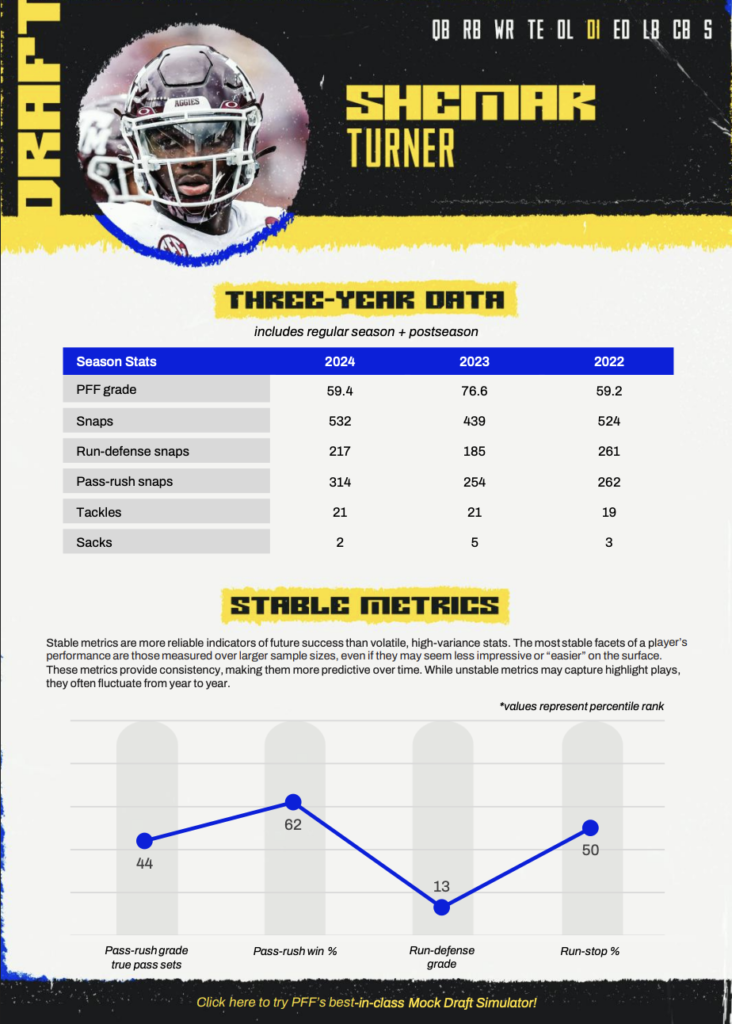

Round 2
33. Cleveland Browns: QB Shedeur Sanders, Colorado
Sanders may be below average in stature and arm talent compared to NFL quarterbacks, but he plays the game cleanly, takes care of the football and is tough as nails with ice in his veins under pressure.
34. Houston Texans: WR Luther Burden III, Missouri
Burden is an ideal “five-tool,” multi-sport athlete for the receiver position in the NFL. The first-round talent is as well-rounded as they come, displaying the ability to succeed at any receiver spot in any offense.
35. Tennessee Titans: EDGE Mike Green, Marshall
Green has only two years of starting experience and not the best competition to measure NFL talent over the past two years. However, he absolutely dominated the way you’d want a future NFL player to with elite pass-rush and run-defense grades in addition to high-90th-percentile numbers in win rate and run stops. He has top-50 all-around ability and projects as a starting-caliber outside linebacker in a 3-4 front.
36. Cleveland Browns: CB Will Johnson, Michigan
Johnson is a long, lean cornerback with elite foot quickness and change-of-direction fluidity. His limited long speed will create questions about his man coverage reliability in the NFL, but having him play off coverage with his eyes on the ball as a zone-scheme wide cornerback could allow him to make impactful plays more often.
37. Las Vegas Raiders: CB Benjamin Morrison, Notre Dame
Morrison is a smart, smooth-moving man coverage cornerback with good instincts for making plays on the ball. Getting back to form after hip surgery and getting a bit stronger are the keys to a future starting outside cornerback role in a man coverage system — but really any system.
38. New England Patriots: WR Jayden Higgins, Iowa State
Higgins is a reliable possession receiver who can run a diverse route tree from any alignment thanks to impressive foot quickness. He won’t be an athletic standout in the NFL, but he’ll often be in the right place at the right time.
39. Chicago Bears (from Panthers): RB TreVeyon Henderson, Ohio State
Henderson, when playing confidently, shines with his agility and long speed. He lacks some size for tackle-breaking and pass-blocking, but he remains a high-effort player in those areas. He seems like a good speed component of an NFL committee, including for receiving work out of the backfield.
40. New Orleans Saints: EDGE Nic Scourton, Texas A&M
Scourton brings an alluring combination of overall size and pass-rush moves to the edge spot, which gives him ideal versatility for 3-4 or 4-3 fronts. However, he does have some length and flexibility limitations. In his current state, he feels like a player who can disrupt and amass pressure but won’t be a high-sack-count rusher.

41. Chicago Bears: EDGE Donovan Ezeiruaku, Boston College
Ezeiruaku is a smaller outside linebacker-type edge rusher who can struggle with the power aspects of the game. However, his quick, smooth style paired with high football IQ and some very nice bend make him an ideal 3-4 pass rush type of defender to draft on Day 2.
42. New York Jets: WR Elic Ayomanor, Stanford
Ayomanor’s size, intelligence at receiver, play strength and experience against press coverage make him an ideal “X” prototype with the talent to become an NFL starter.
43. San Francisco 49ers: LB Carson Schwesinger, UCLA
Schwesinger is light for an NFL linebacker, but his elite processing speed and intelligence give him starter and impact ability as a Mike or Will linebacker for a 4-3 defense.
44. Dallas Cowboys: RB Quinshon Judkins, Ohio State
Judkins is a strong north-to-south runner who generates impressive speed-to-power for consistent yards after the catch. However, his game lacks the creativity needed to consistently win in the NFL, independent of his offensive line. Behind a good line, he could rack up yards. Behind a subpar one, he could struggle to stand out.
45. Indianapolis Colts: S Nick Emmanwori, South Carolina
Emmanwori is a tricky prospect who will require a leap of faith, considering where he’s likely to be drafted. His elite athleticism and playmaking ability suggest his ceiling could be on par with a player like Kerby Joseph, but his underwhelming box play and questionable technique and instincts are more reminiscent of Isaiah Simmons, who was drafted in the first round in 2020 but has struggled to find a natural NFL position.
46. Los Angeles Rams: TE Mason Taylor, LSU
Taylor is young and could still be growing into his talent and, more importantly, his strength. In his current form, he is a TE2/3 candidate — more of a move tight end detached from the line of scrimmage as a receiver — but if he gets stronger, he can be a more versatile and consistent contributor.
47. Arizona Cardinals: CB Trey Amos, Mississippi
Amos brings an ideal blend of size, movement skills and coverage scheme versatility to the cornerback position. While his explosiveness and speed aren’t anything special, his 2024 film shows he has a CB2 floor in the NFL with the potential to be a CB1.
48. Miami Dolphins: T Aireontae Ersery, Minnesota
Ersery brings alluring size and length to the tackle position for the NFL. He has good hands, an explosive first step forward and quick footwork to be an impactful zone run blocker, but his naturally high-waisted build impacts his leverage and may inhibit him from keeping NFL rushers in front of him.
49. Cincinnati Bengals: S Xavier Watts, Notre Dame
Watts is the best ball-hawking safety in this class thanks to his intelligence and ability to break on the football. That will have him drafted somewhere on Day 2, even with his tackling woes.
50. Seattle Seahawks: G Tate Ratledge, Georgia
Ratledge isn’t the most dynamic athlete, but his solid pass-blocking technique and downhill power in the run game give him a chance to be a starter in the NFL.
51. Denver Broncos: WR Jalen Royals, Utah State
Royals may lack difference-making NFL athleticism, but he is a strong possession receiver who can line up anywhere with plus after-the-catch ability.
52. Seattle Seahawks (from Steelers): CB Shavon Revel, East Carolina
Revel is the ideal Day 2 athletic alien to draft and develop, despite inconsistent anticipation and technique in his current form. His physical gifts (including height and length) point to press-man coverage being his home in the NFL, but it will be quite the adjustment for him to go from one year of starting experience in the AAC to the NFL – especially off a torn ACL.
53. Tampa Bay Buccaneers: EDGE Bradyn Swinson, LSU
Swinson didn’t become a full-time starter until his final season, but in his current form, he shows very active hands and a good understanding of rushing the passer to yield consistently high pass-rush win rates. If he continues to get stronger defending the run, he can become a starting 3-4 edge player with impact pass-rush potential.
54. Green Bay Packers: CB Darien Porter, Iowa State
Porter is a rare prospect. He is a wide receiver-turned-cornerback with ideal ball skills, ranks above the 95th percentile in height and length and has an elite track background that translates to the field. He is still raw as just a one-year starter despite being a sixth-year player, but his special teams impact and sky-high potential are worth drafting in the middle rounds.
Click here for more draft tools:
NFL Draft Big Board | Mock Draft Simulator | NCAA Premium Stats
2025 PFF Draft Guide | Mock Draft Hub | Prospect Data Profiles
Draft Position Rankings
55. Los Angeles Chargers: TE Elijah Arroyo, Miami (FL)
Arroyo is a receiving tight end through and through who can line up as a wingback and in the slot. An NFL team hoping for a consistent blocker will be disappointed, though. If given a chance to show off his all-around athleticism, he can be a contributor as a big slot type.
56. Buffalo Bills (from Vikings through Texans): S Kevin Winston Jr., Penn State
Winston’s tape and the athleticism that he showed off in 2023 made him a prospect worthy of going in the first round. While his recent injury muddies his projection, he’s still one of the top safeties available if he can fully recover.
57. Carolina Panthers (from Rams): EDGE Princely Umanmielen, Mississippi
Umanmielen feels like a specialized finesse pass-rushing outside linebacker in a 3-4 defense. If you want him to be more versatile than that, you might be disappointed in the lack of consistency. However, if you put him in that role correctly, he can be a backfield difference-maker for you on some of the most pivotal plays of the game.
58. Houston Texans: C Jared Wilson, Georgia
Wilson may be just a one-year starter, but he has the movement skills to be a starting center in the NFL if he can continue to improve his intelligence and anticipation with more snaps.

59. Baltimore Ravens: CB Azareye’h Thomas, Florida State
Thomas is a long, quick-footed press-man cornerback who showcases good natural movement skills and playmaker instincts. He lacks some strength in a few areas, but he plays the position with high intelligence to be a scheme-versatile CB2 projection for the NFL.
60. Detroit Lions: EDGE Landon Jackson, Arkansas
Jackson is a fundamentally sound player with alluring length and surprising cornering ability for a player of his size. His overall pass-rush win percentage has been low throughout his career, which presents him as a high-floor, versatile defensive end who can be a solid starter for odd or even fronts.
61. Washington Commanders: EDGE JT Tuimoloau, Ohio State
Tuimoloau presents a good floor for an edge rusher in a 4-3 defensive front. His pass-rush win percentage has been average over the last two years, with quite a few clean-up sacks on his stat sheet, but he improved in his true pass-rush win rates in 2024. He is a good Day 2 prospect to bet on because you’ll get a spot starting/rotational floor out of him.
62. Buffalo Bills: LB Demetrius Knight Jr., South Carolina
Knight will be one of the oldest prospects in the 2025 NFL Draft, but he is a mature player with good processing and fundamentally sound tackling. His run-defense angles can be a bit overaggressive, but you’ll take that trade-off due to how well he moves in coverage and when pursuing ball carriers.
63. Kansas City Chiefs: DI Darius Alexander, Toledo
Alexander was lightly recruited and was a late bloomer in college football (he will be 25 in his rookie season), but his measurables and strength are NFL-caliber. He is a contributing NFL defensive lineman at worst due to his strength profile, with starting-caliber impact potential in odd and even fronts.
64. Philadelphia Eagles: DI T.J. Sanders, South Carolina
Sanders is a true 3-technique who wins with linear and lateral quickness to shoot gaps and disrupt. He must improve his hand precision and play strength to be a full-time starter. At worst, he is a contributing rotational 3-technique.
Round 3
65. New York Giants: DI Omarr Norman Lott, Tennessee
Norman-Lott possesses more NFL potential than his snap counts and stats say; look at his grades and win rates for a clearer picture. He is an athletically gifted, undersized 3-technique who, with better hand usage and pass-rush plans, can be a contributing starter.
66. Kansas City Chiefs (from Titans): EDGE Jared Ivey, Mississippi
Ivey is a physically gifted player with devastating power in his hands to hold the point of attack and stack and shed consistently. He lacks the speed and lower body flexibility to be a speed threat as a 4-3 defensive end, so his best fit is likely more inside for a 3-4 front that would maximize his special strength every play.
67. Cleveland Browns: RB Cameron Skattebo, Arizona State
Skattebo plays the game in a manner that is easy to love: with a massive chip on his shoulder. NFL teams will gravitate toward his mentality, balance, tackle-breaking ability and after-contact consistency. He has the physical makeup of a three-down back.
68. Las Vegas Raiders: WR Jaylin Noel, Iowa State
Noel is a compact and powerful slot receiver who wins with a good first step and can succeed in an NFL offense where the quarterback holds the ball a little longer in the pocket. He’ll need to be more dynamic after the catch to earn a consistent starting role in the league.
69. New England Patriots: RB Dylan Sampson, Tennessee
Sampson is a speedster who pairs explosiveness with patience and vision. He has big-play potential behind any blocking scheme and could develop into a plus receiver, though he must cut down on fumbles.
70. Jacksonville Jaguars: DI CJ West, Indiana
West is on the shorter side (length) but has good size (mass) and burst as a nose tackle who can have strong reps in run defense and some surprisingly impactful reps as a pass-rusher. If he can keep his pad level down, he can be a contributing rotational player in the NFL, preferably in a 4-3 front.
71. New Orleans Saints: QB Jalen Milroe, Alabama
Milroe is the most physically gifted quarterback in the 2025 draft class, but he is still far too inconsistent in when and how he delivers the football. In a perfect world, he would be drafted with a plan to let him sit and develop.
72. Chicago Bears: S Andrew Mukuba, Texas
Mukuba’s lack of a run-defense skill set may turn off some teams, but his instincts and athleticism in coverage make him a top prospect. His game is reminiscent of Devin McCourty, who excelled as a true free safety later in his career with the Patriots but had the savvy to make plays from a variety of alignments because of his football intelligence.
73. New York Jets: DI Alfred Collins, Texas
Collins is a long, strong interior defensive lineman with the versatility to play anywhere from 0-technique to 5-technique. His pass-rush profile and inability to disengage quickly limit his ceiling, but his versatility and strength give him a high floor. He projects as a rotational player with starting potential.
74. Carolina Panthers: S Lathan Ransom, Ohio State
Toughness and tenacity are Ransom’s calling cards, which he makes good use of in all facets of the game. While he may lack the tools some other prospects have, he has the instincts and awareness to make up for it.
75. San Francisco 49ers: T Jonah Savaiinaea, Arizona
Savaiinaea’s feet and pass-blocking technique should keep him in the league for a while, regardless of his position. If he can get stronger, he has a chance to stick as a starter at right tackle or inside for a zone-rushing team.

76. Dallas Cowboys: WR Tre Harris, Mississippi
Harris projects as an alluring WR3 type for an offense that likes to push the ball down the field. His route tree and separation rates leave something to be desired, but he can keep a defense honest with his field-stretching ability.
77. New England Patriots (from Falcons): EDGE Oluwafemi Oladejo, UCLA
While Oladejo offers positional versatility, an NFL team will get the best return on investment by keeping him at edge defender. Oladejo’s athleticism, explosiveness and long arms are a nice foundation, and it appears his best years as a pass-rusher are still ahead of him.
78. Arizona Cardinals: T Ozzy Trapilo, Boston College
Trapilo brings an ideal build and a scheme-versatile football IQ to the tackle position. His size and versatility as a left and right tackle will make him a swing tackle at worst, with the potential to be a solid starter for any run scheme.
79. Houston Texans (from Dolphins through Eagles and Commanders): DI Vernon Broughton, Texas
Broughton needs to refine his hand placement and technique to become a more effective one-on-one winner at the next level. However, even in his current form, his length and strength provide valuable versatility as a two-gapping defensive lineman, with his best fit likely coming as a 3-4 defensive end.
80. Indianapolis Colts: EDGE Jack Sawyer, Ohio State
Sawyer is a high-floor, all-around 4-3 defensive end with a starting-caliber projection. The question is whether you believe there is more there for him as a pass-rusher. If you do, you can convince yourself that he’s a top-20 player. If not, an early Day 2 range feels like his floor.
81. Cincinnati Bengals: T Wyatt Milum, West Virginia
Milum is a strong run blocker between the tackles with good power at contact, heavy/reliable hands, and good grip strength. He can get in trouble when truly left on an island in pass protection, which is why a move inside could be best to get the most out of his strength while mitigating flexibility/agility risks.
82. Seattle Seahawks: EDGE Josaiah Stewart, Michigan
Stewart is a juiced-up pass-rusher with less-than-ideal measurables. His effort and leverage give him a chance to win any rep, but he lacks pass-rush nuance to win with more than those attributes and a good first step. His best spot in the NFL might be as an off-ball Sam linebacker, where he can be used as a blitzer more than just a straight edge defender (think Uchenna Nuwosu).
83. Pittsburgh Steelers: QB Will Howard, Ohio State
Howard checks a lot of boxes: experience, size and a willingness to attack all coverages. He doesn’t bring special arm talent, but he could develop into an NFL starter.
84. Tampa Bay Buccaneers: LB Chris Paul Jr., Mississippi
Paul needs to add some mass to his frame, but he can eventually become a starting Will linebacker in the league, thanks to his athleticism and intelligence.
85. Denver Broncos: RB Kaleb Johnson, Iowa
Johnson is a physically gifted running back who excels with the ball in his hands. As an early-down player, he can be successful behind any blocking scheme with good vision, light footwork and impressive burst and power. However, his lack of polish and reliability in third-down situations could keep him from being an every-down running back.
86. Los Angeles Chargers: WR Jack Bech, TCU
Bech, at his best, has the makings of an impact WR2 at the NFL level, but he needs to continue to grow to win consistently in his releases against press and in his routes. His sure hands and playmaker mentality won’t be an issue.
87. Green Bay Packers: EDGE Jordan Burch, Oregon
Burch is a high-potential player with athletic and physical gifts you can’t teach. After finding his sweet spot of size and body composition, he can play in both odd and even fronts but projects best as a 4-3 defensive end. If he continues to master more pass-rush moves and hand usage, he can be a starter and a contributing player.
88. Jacksonville Jaguars (from Vikings): TE Harold Fannin Jr., Bowling Green
Fannin is a strong receiving tight end with great value after the catch. His blocking reps are good enough to keep him inline as a TE2 or as a wingback on occasion, but his bread and butter in the NFL will be as a tight end who you can quickly get the ball to for after-the-catch production in a tight end-centric passing attack.
89. Houston Texans: RB RJ Harvey, Central Florida
Harvey ranks well in PFF’s wins above average metric due to high missed tackles forced averages as a rusher and a receiver and his production in the passing game. If he plays with more urgency and violence, he could be a productive NFL running back.
90. Los Angeles Rams: CB Dorian Strong, Virginia Tech
Strong, ironically, lacks some strength in press-man coverage and run-defense situations near the line of scrimmage, but he is a smart, competitive zone-scheme cornerback with a natural ability to get his hands on passes and cause constant disruption at the catch point.
91. Baltimore Ravens: EDGE David Walker, Central Arkansas
Walker is a highly productive and decorated FCS player. His size limitations will make him a Day 3 pick at best, but he mitigates it as best he can and is a high-effort player who lives in backfields. Some team will likely take a flier on him late as a stand-up pass-rush specialist.
92. Seattle Seahawks (from Lions through Jets and Raiders): TE Terrance Ferguson, Oregon
Ferguson is a nice receiving tight end with the length to play some inline snaps. His lower run-blocking impact marks indicate that an NFL team won’t want to use him much in that way. His true value is as a receiver and a TE2.
93. New Orleans Saints (from Commanders): WR Kyle Williams, Washington State
Williams is undersized, but his game hints at big-time potential. His release package, quick feet, and ability to build speed as routes progress give him a starting-caliber ceiling with, in theory, the versatility to line up at any of the three receiver spots.
94. Cleveland Browns (from Bills): WR Xavier Restrepo, Miami (FL)
Restrepo brings a strong slot receiver skill set to the NFL, where his production, separation scores and great hands give him a high floor with WR2/WR3 potential despite some high-end athleticism and size limitations.
95. Kansas City Chiefs: RB DJ Giddens, Kansas State
Giddens brings good eyes, patience and anticipation to a backfield, finding open space between the tackles with good one-cut ability and long strides for long speed. He needs to play with more violence to gain yards after contact if he is to truly make a name for himself in a running back rotation.
96. Philadelphia Eagles: WR Savion Williams, TCU
Williams’ stats won’t “wow” evaluators, but his tape and his measurables sure will. He’s a very versatile and potentially high-impact NFL player on the line, in the backfield or as a returner.
97. Minnesota Vikings (Compensatory Selection): DI Jamaree Caldwell, Oregon
Caldwell brings intriguing quickness on top of ideal size for an NFL nose tackle. He likely won’t be a big backfield presence, but he can be a good rotational nose tackle for an odd-front defense.
98. Miami Dolphins (Compensatory Selection): CB Jacob Parrish, Kansas State
Parrish has the agility, fluidity and recovery speed to thrive as a nickel defender in the NFL. As long as he remains a reliable tackler, he has the potential to be a starting nickel and an important role player in man coverage.
99. New York Giants (Compensatory Selection): T Marcus Mbow, Purdue
Mbow is small and struggles with NFL-level strength in pass protection and when displacing in the run game. But he moves extremely well and should get a shot to start at guard or tackle at some point during his rookie contract.
100. San Francisco 49ers (Special Compensatory Selection): DI Shemar Turner, Texas A&M
Turner played at just about every spot on Texas A&M’s defensive line, thanks to his active, violent hands and unwavering effort. He has some length and overall size limitations, but he feels like a guy an NFL coaching staff will push for on Day 2 of the draft.

101. Los Angeles Rams (Special Compensatory selection: EDGE Kyle Kennard, South Carolina
Kennard shows a good understanding of how to win as a pass-rusher in varying situations in both odd and even fronts. He is lean and long, which is a plus for arm length but a negative when holding up versus the run. His handwork and footwork show a great baseline to build a successful pass-rush profile in the league as a Day 2 selection.
102. Detroit Lions (Special Compensatory selection: WR Isaac TeSlaa, Arkansas
TeSlaa began his college career at the Division II level — where his father also played receiver — before making the leap to the SEC. While his production didn’t pop against top-tier competition, his size, explosiveness and sure hands give him a starting-caliber ceiling as a “big slot” option with developmental upside.
This news was originally published on this post .









Be the first to leave a comment